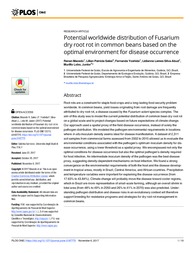Potential worldwide distribution of Fusarium dry root rot in common beans based on the optimal environment for disease occurrence.
Potential worldwide distribution of Fusarium dry root rot in common beans based on the optimal environment for disease occurrence.
Autoria: MACEDO, R.; SALES, L. P.; YOSHIDA, F.; SILVA-ABUD, L. L.; LOBO JUNIOR, M.
Resumo: Root rots are a constraint for staple food crops and a long-lasting food security problem worldwide. In common beans, yield losses originating from root damage are frequently attributed to dry root rot, a disease caused by the Fusarium solani species complex. The aim of this study was to model the current potential distribution of common bean dry root rot on a global scale and to project changes based on future expectations of climate change. Our approach used a spatial proxy of the field disease occurrence, instead of solely the pathogen distribution. We modeled the pathogen environmental requirements in locations where in-situ inoculum density seems ideal for disease manifestation. A dataset of 2,311 soil samples from commercial farms assessed from 2002 to 2015 allowed us to evaluate the environmental conditions associated with the pathogen's optimum inoculum density for disease occurrence, using a lower threshold as a spatial proxy. We encompassed not only the optimal conditions for disease occurrence but also the optimal pathogen's density required for host infection. An intermediate inoculum density of the pathogen was the best disease proxy, suggesting density-dependent mechanisms on host infection. We found a strong convergence on the environmental requirements of both the host and the disease development in tropical areas, mostly in Brazil, Central America, and African countries. Precipitation and temperature variables were important for explaining the disease occurrence (from 17.63% to 43.84%). Climate change will probably move the disease toward cooler regions, which in Brazil are more representative of small-scale farming, although an overall shrink in total area (from 48% to 49% in 2050 and 26% to 41% in 2070) was also predicted. Understanding pathogen distribution and disease risks in an evolutionary context will therefore support breeding for resistance programs and strategies for dry root rot management in common beans.
Ano de publicação: 2017
Tipo de publicação: Artigo de periódico
Unidade: Embrapa Arroz e Feijão
Palavras-chave: Doença de planta, Feijão, Fusarium solani, Phaseolus vulgaris
Observações
1 - Por padrão são exibidas publicações dos últimos 20 anos. Para encontrar publicações mais antigas, configure o filtro ano de publicação, colocando o ano a partir do qual você deseja encontrar publicações. O filtro está na coluna da esquerda na busca acima.
2 - Para ler algumas publicações da Embrapa (apenas as que estão em formato ePub), é necessário ter, no celular ou computador, um desses softwares gratuitos. Sistemas Android: Google Play Livros; IOS: iBooks; Windows e Linux: software Calibre.
Acesse outras publicações
Acesse a Base de Dados da Pesquisa Agropecuária (BDPA) para consultar o acervo completo das bibliotecas da Embrapa.

